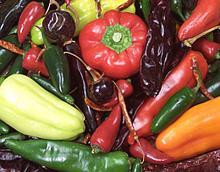
SAFARI
Users
Buying & Storing Chilis
Working with Chilis
- Methods and HintsMain Chili Page
- varieties, powders, potions, health, hotness scale
Buying & Storing Chilis
Fresh Chilis - Green or Red
- These should be crisp and bright and without wrinkles when purchased, and have no spots that might be going bad.
- Leave them out on a counter for a couple of hours to make sure they don't have excess surface water, then bag loosly in plastic (the bag should be able to breath) or paper. Store in the refrigerator.
- Bell peppers I bag separately in small bags open at the top. This keeps them well and isolates any one that goes to rot.
- Stored as above, green bells should keep at least two weeks in a good refrigerator, some hot green chilis for three to four weeks. Red ripe chilis will generally not keep as long as green ones. There are exceptions, such as Thai chilis, where the reds last longer.
Dried Red Chilis
- These should be bright red to black red depending on type and should be shiny on the surface. A dull surface indicates excessive age. They should be somewhat flexible rather than brittle.
- If you see the surface become dull or red color fading to orange, or evidence of bugs, discard and buy new ones.
- Store in a sealed container in a cool place away from light and they should keep a year or so.
Working with Chilis
Chilis are used unripe (green, or sometimes other colors), red ripe, and dried red. Dried green bell peppers are used as a flavoring additive in the food industry. Chilis are at their hottest when mature green and about to turn color. Some hotness is lost in drying.
Caution:
After working with hot chilis, especially fresh ones, immediately wash your hands, tools and work surfaces with strong detergent, soap or cleanser. Until then do not touch your eyes or genital areas - or anyone else's, if you ever want to be allowed to touch them again. If you accidentally do, the sting goes away in 10 to 20 minutes and will do no actual harm.I need Releif!
For the mouth, Ice Cream is the treatment of choice. Other milk products will help. Water doesn't help at all and alcohol very little. For external burn, wash with strong soap solution and wait for it to go away. In neither case is any real harm being done (unless if you've been eating million Scovile chilis).Chilis are Safe:
Cookbooks telling you hot chilis will severely burn or blister you hands (so wear rubber gloves) are either blowing smoke or have extrordinarily tender hands. Exception: hands with injuries will feel pain. Chili hotness is a nerve receptor thing and does no physical damage. Being a guy who works hard, my hands are too tough to have ever felt chili sting, but society ladies or fashion models might have hands that tender (but wouldn't likely be chopping chilis anyway). Of course, when working with chilis over 500,000 Scoville, more caution is in order, but you won't be buying any like that at your local market.Cleanup:
The hotness in chilis is oil soluble and not water soluble. Just rinsing won't get rid of it, you have to use detergents, cleansers or other potions you'd use to clean oily things.Where the heat is:
The hotness of a chili resides in oil droplets clinging to the internal membranes that hold the seeds, not in the seeds as many cookbooks tell you. If your chili is too hot you can cool it by carefully removing these membranes. In a dried chili, or one that has been abused, the hotness has been smeared onto the seeds and flesh.Chopping Fresh Chilis:
Cut the cap off, then cut it in half lengthwise. Remove seeds and membranes if you want it milder. Squish each half flat, skin side down, and, with a very sharp knife, slice lengthwise into thin strips. Finally, arrange the strips into a bundle and slice crosswise very thin. No further chopping is required in most cases.Chopping Dried Chilis:
This can be a problem. They are tough and don't grind in a mortar and if you try to chop them the pieces jump all over the place. If I don't want them too small I use a pair of scissors and cut them into thin slices. A couple of presses with a knife blade through the stack of slices is probably all the chopping you will need. Most of the time, though, I just run them to flake or powder in a whirling blade coffee/spice grinder (be careful not to breath the dust).



